Roses are known for being challenging to grow as they need quite a bit of maintenance, such as regular pruning, watering, and winter protection.
Despite this, spring is usually a happy season for gardeners as fresh foliage emerges on roses and excitement grows for colorful rose flowers to bloom in all their glory. In this article, find out what is eating my rose leaves.
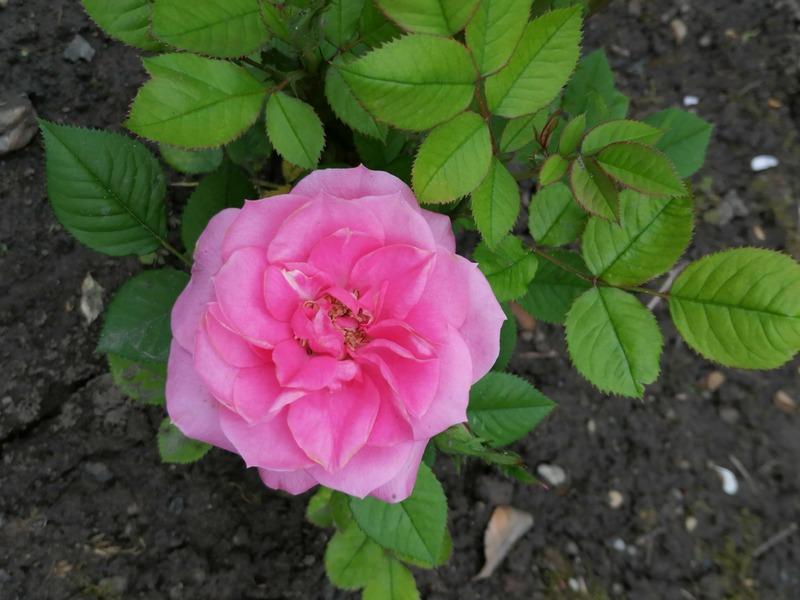
Rose Slugs, Japanese Beetles, and Fuller Rose Beetles are the most destructive pests that eat rose leaves.
However, the thrill rapidly wears off when you notice holes in the leaves of your rose plant. Roses are attacked by many pests and diseases. Planting resistant types can prevent some severe disease concerns, but insect pests aren’t as readily avoided.
Rose pests include a number of insects that feed on the plant and can cause substantial damage to roses if left unchecked. These pests include caterpillars, red spider mites, leaf rolling sawflies, aphids, rose slug sawflies, and thrips. However, Rose Slugs (sawfly larvae), Japanese Beetles, and Fuller Rose Beetles are the most destructive rose leaf-eating pests.
Finding the most effective method of eradicating the bugs feeding on the leaves of your roses will require you to identify the offender first correctly. So, keep reading!
Rose Pests
Are the leaves of your rose littered with holes? Unfortunately, this occurs more frequently than you might expect. Even though it’s annoying to find roses with holes in them, there are a lot of potential causes for this problem, and most of them are relatively simple to fix.
Continue reading to get more details on what to do if the leaves of your rose bushes have holes in them.
Aphids
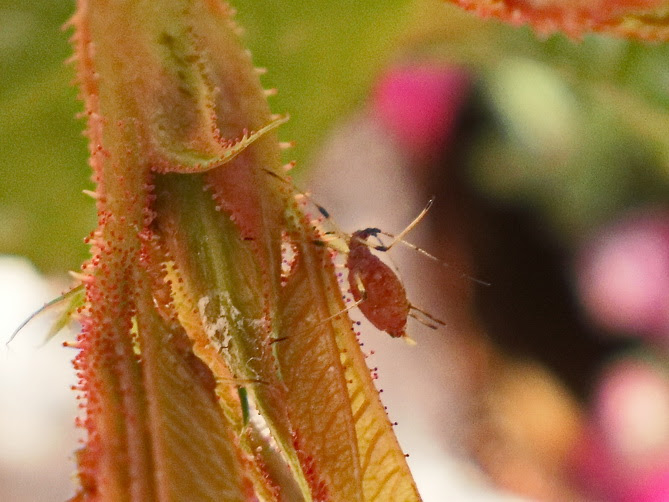
Since rose aphids are green or pink, small populations could be hard to spot.
Aphids are one of the most frequent types of pests that affect roses. These teeny, pear-shaped sucking insects have a strong preference for feeding on fresh, juicy growth.
There are several aphid species that can be yellow, green, or almost black in color. You can immediately spot aphid colonies on most plants. However, finding them on roses is hard because it is the green and pink aphids that affect the roses the most.
Aphids secrete a sticky substance known as honeydew. Honeydew, in turn, draws the obscene, blackish-gray fungus known as sooty mold, which further damages the rose plant.
A single aphid does not pose a significant risk; however, aphid colonies can expand at a startlingly rapid rate. As they continue to feed on roses, the plant will begin to pucker, get brittle, and turn yellow, and eventually, it might die.
Control
You can get rid of aphids by hosing off the rose shrub with a powerful stream of water. However, you will need to repeat this activity several times for the best results, and all parts of the rose plant, including the undersides of the leaves, must be washed.
In addition, there are organic insecticides that work by trapping the aphids in a sticky substance to immobilize them, which you can also use to control aphid populations on rose plants.
Lastly, you can try introducing ladybirds and other small birds to your rose garden. These creatures are aphids’ natural predators. Therefore, encouraging them in the garden is always a good idea if you want to control aphids in a biological manner.
Leaf-cutter Bees
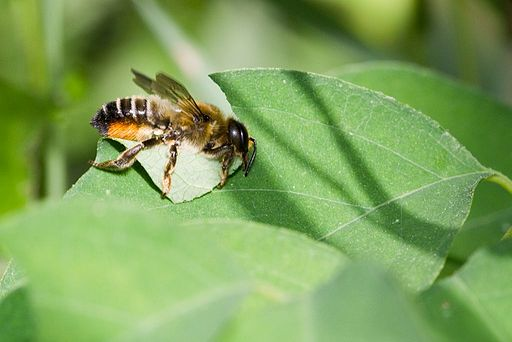
Many gardeners consider leaf-cutter bees pests as they can ruin the foliage on roses.
Leaf-cutter bees are native species that are generally benign and only cause very slight damage to the rose plants. They are solitary, meaning they do not live in colonies.
The females construct their nests in pre-existing cavities, such as those found in bee nest boxes, hollow twigs, or decaying wood. If any of these things are present in the vicinity of your rose plants, you must keep an eye out for the leaf-cutter bees.
The only damage that they create is to the looks. So, if you notice that the leaf edges of your roses are being eaten away in the shape of half circles, then you probably have a leaf-cutting bee in your rose shrub.
Control
No chemical treatments should be used since leaf-cutter bees are crucial pollinators of numerous crop plants as well as native wildflowers. Instead, take pride in the fact that you’ve provided an environment where a natural pollinator can flourish.
However, if you are too concerned about your rose plants’ aesthetics and want to protect your roses from leaf-cutter bees, you can cover the plants using a net.
Japanese Beetles
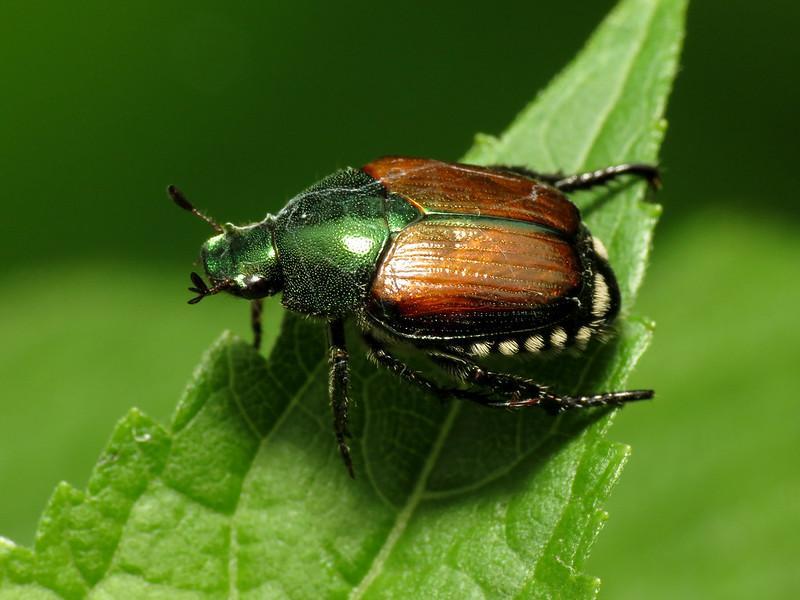
Roses and other healthy flowering plants can typically withstand Japanese beetle feeding.
Adult Japanese beetles are most likely to blame if damage to rose foliage appears around the end of June or the start of July.
Their copper-colored back and bluish-green head make them simple to identify. Japanese beetles will consume the petals and skeletonize the leaves of rose plants, turning them into lace-like leaves as they do so.
However, they are also capable of devouring blossoms and buds
They have a propensity to gather in big numbers and are capable of causing a significant amount of harm in a short amount of time.
Control
Hand-picking is one of the best ways to remove Japanese beetles from a home garden.
Japanese Beetles are typically easier to manually remove in the morning and evening when they are dormant.
However, you can leave the Japanese beetles on the rose plant if you notice any white patches on the beetles’ back. These are the eggs of a Tachinid fly that will hatch into a larva that will eat the beetle and eventually kill it.
Although many insecticides have been registered to combat the Japanese beetle, their efficacy is frequently constrained. In most cases, it is necessary to spray repeatedly, and what is even worse is that they are highly poisonous to bees and other pollinators.
Thrips
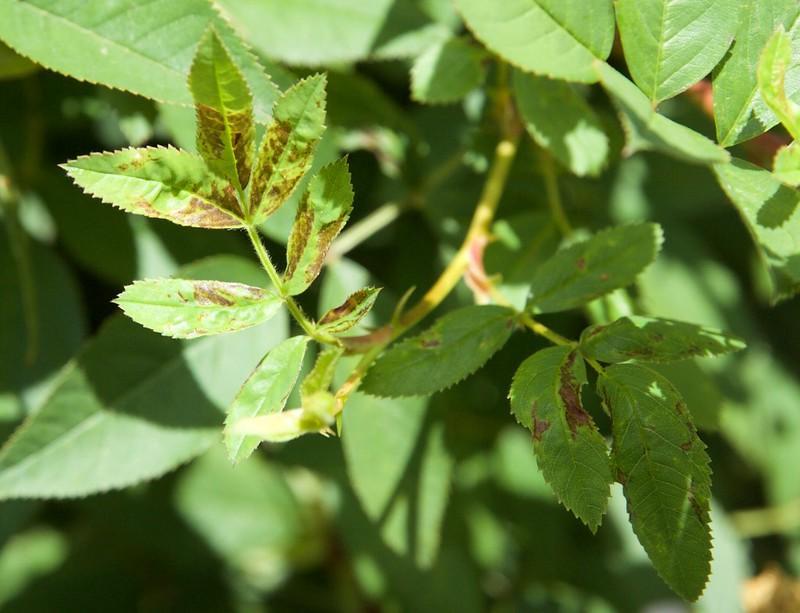
Thrips are a major pest for rose growers and can be very difficult to eradicate.
Western flower thrips are tiny (1/20′′), thin, brown to yellow insects that damage the leaves and flower buds of many ornamental and other plants.
Thrips will gnaw at the petals’ margins and sever pieces of tightly furled rose buds, causing buds to distort and leaving brown streaks on them.
Thrips typically do more damage in landscapes where roses are grown in vast swathes. Rose thrips infestations are very upsetting for gardeners since they ruin your blossoms and are also very challenging to manage.
In the case of thrips, it is typical for the damage to be noticed before the bug itself, at which point it is too late to do anything about it anyway.
Control
Since thrips live on the inside of rose buds and their populations can expand quickly, they are often very challenging to manage.
Natural predators that can aid in the fight against thrips include pirate bugs and other parasitic insects. If that fails, you can use a selective insecticide.
However, do not use a general insecticide as it will also kill the thrips’ predators.
Even yet, thrips are challenging to eradicate using pesticides. Therefore, a variety of techniques, including horticultural oils, insecticidal soaps, and good horticultural practices, are frequently used together to get the results.
Rose Slugs
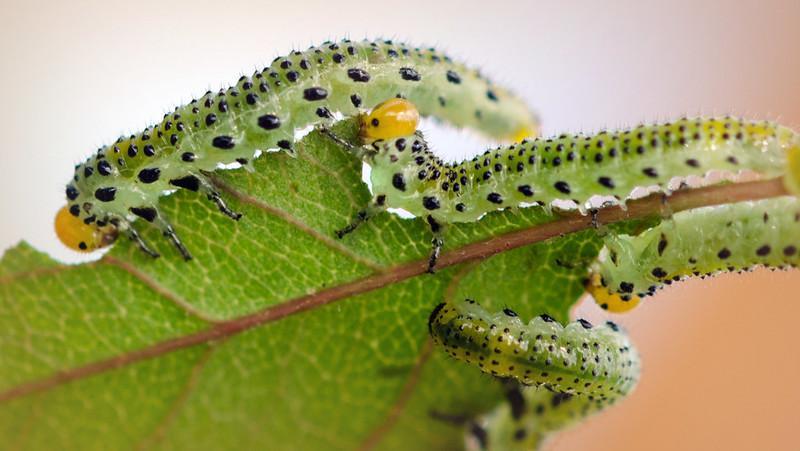
Although they resemble caterpillars, rose slugs are not the same thing.
Rose slugs can be found most frequently on rose plants between the months of May and June. They look like caterpillars but are not, and their bodies are covered in a slimy coating that gives them the appearance of slugs.
However, Rose slugs aren’t slugs either but the larvae of sawflies. They can reach a length of up to 3/4 inches.
Rose slugs consume the leaves of rose bushes as food. When they are young, the holes they create are so little that they only like the brown spots on rose leaves.
However, it is their adult stage when they may eat right through a leaf and cause significant damage to the plants.
Adult rose bugs devour the soft tissue of leaves, leaving the veins and giving the leaf a skeletonized look. Damaged leaves eventually turn yellow and fall off the plant.
Control
When scouting for rose slugs, you should focus on the undersides of foliage because that is where they can be found most frequently. The easiest way to control them is to knock them off the plant by hand or by hosing the leaves first thing in the morning.
Rose slugs can also be manually removed in small quantities from the leaves or either crushed and drowned in a pail of soapy water. However, more severe infestations call for the use of insecticides, like spinosad.
Fuller Rose Beetles
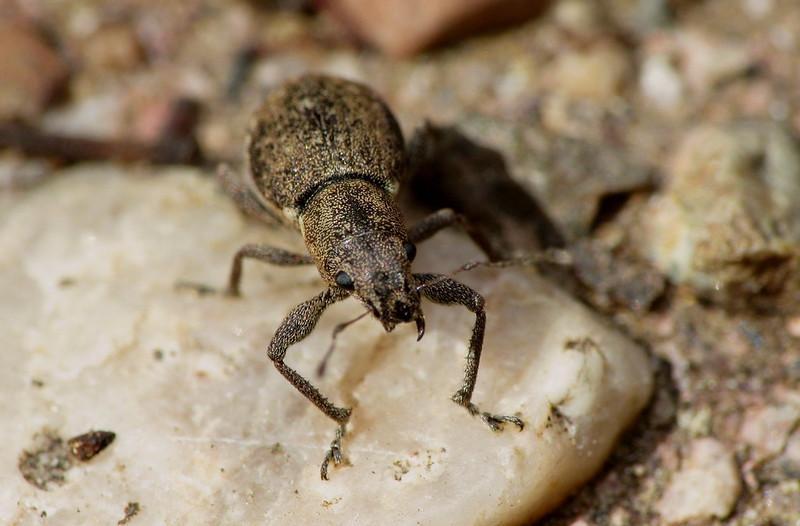
Adult Fuller rose beetles resemble vegetable weevils in color and have long, grayish-brown snouts.
Another bug that feeds on rose leaves and gives them a ragged or notched appearance is the fuller rose beetle. This snout beetle pest lacks wings and has a brown body with protruding eyes. The larger rose beetle can cause significant harm to roses.
They consume both the leaves and the blossoms of the plant. Even if you remove them all, a new family will start the following season as they are all female and lay eggs in the soil.
They cause very distinctive damage. Around the holes where they’ve been eating, there will be ripping with frayed edges. The only part that won’t be devoured is the thick, large vein that runs down the middle of the leaf they are eating.
Control
Pruning the lower section of the rose bush will prevent adults emerging from the soil from climbing onto the leaves. Use sticky traps on the main trunks to catch the adults before they can climb onto the plant.
The larger rose beetle can be easily controlled by picking the beetles off the rose bush and putting them in a pail of soapy water. This is the most straightforward approach to handling the pests, and it will kill the beetles.
Caterpillars
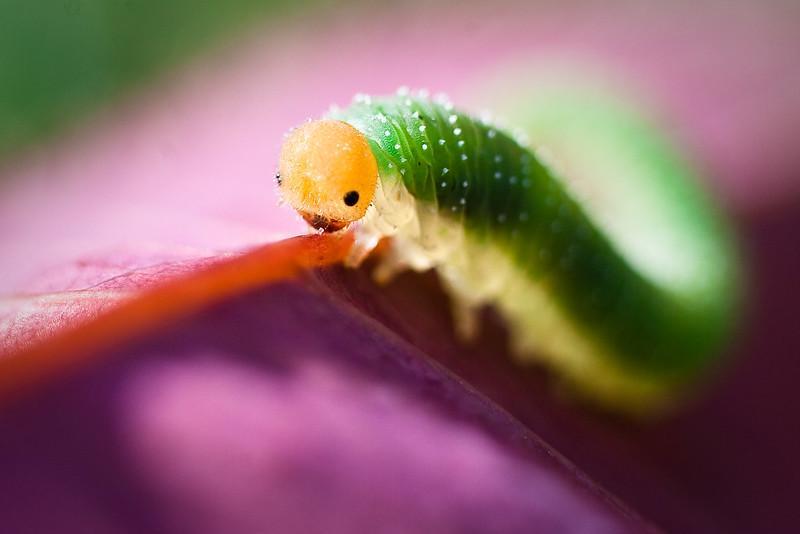
Caterpillars that eat rose leaves include orange, rose tortrix, and rose budworm.
Caterpillars, which are the larvae of butterflies and moths, are another common pest of roses. Caterpillars feed on the foliage of roses.
The damage they cause typically takes the form of several uneven regions clustered close to the leaf’s center, or the leaf may be completely consumed.
However, the look and the damage typically differs from one species of caterpillar to another.
These itty-bitty critters will clamber up the rose stems in order to reach the leaves of the roses, which they will then devour with great zeal.
In most cases, caterpillars that feed on leaves won’t do significant damage to the plant until there are a substantial number of them.
Control
The majority of caterpillars can be removed by hand and then placed in a container filled with water to kill them. Similarly, using Bacillus thuringiensis is another option that does not involve using hazardous chemicals.
However, if there are already too many of them for this to be an option, then, unfortunately, the only other choice is to spray them with insecticide.
Spider Mites

Spider mites are tiny spiders and a common rose pest that lives underneath rose leaves.
Spider mites can be difficult to control in the rose bed or garden. They are referred to as spider mites because of the delicate white webs that they produce while feeding. They are clearly visible with the use of a magnifying lens, and regrettably, the damage caused by their eating of your roses is readily apparent even to the unaided eye.
It is essential to be aware of the early warning symptoms of spider mites to stop the infestation before it gets out of hand. Spider mites can cause browning or bronzing of the leaves/foliage, as well as scorching of the leaves, on your roses. If the harm to the foliage is not treated, it can result in the loss of leaves and potentially the death of the rose plant.
Control
Roses suffering from the effects of drought and are grown in hot, dusty environments are particularly susceptible to infestation of spider mites.
The most effective technique to control these nasty bugs is to introduce their natural predator, the Western predatory mite, into your gardens.
Insecticides should only be used as a last option in the fight against spider mites. Some pesticides destroy the natural predators of mites and prevent them from returning.
Diseases
Diseases that commonly affect rose plants are black spot disease and powdery mildew. Sometimes the damage due to these diseases also looks as though the leaves or roses have been eaten. So, it is important to know the difference so you can choose the right course of treatment for your plants. Keep reading to learn more!
Black Spot Disease
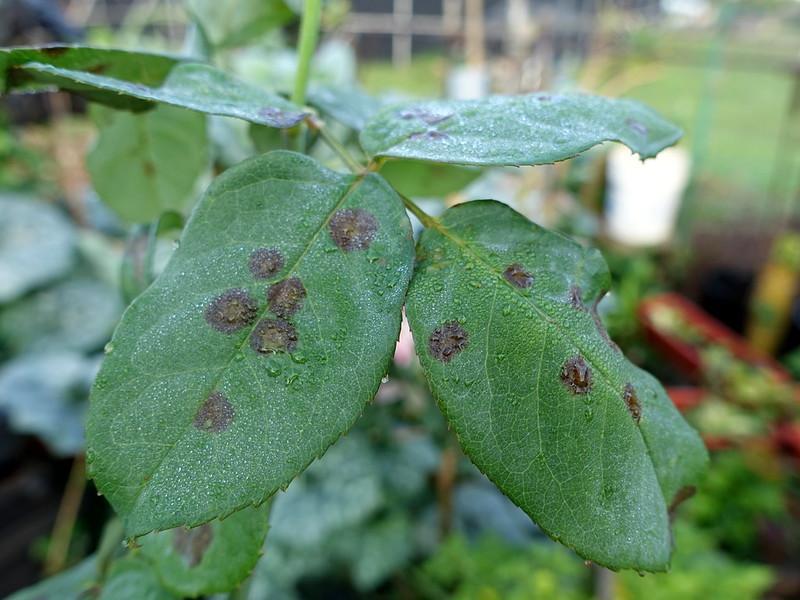
The most common fungal disease of roses globally is black spot (blackspot).
Black spot is a fungal disease that thrives in warm, wet, and humid weather. It is caused by a fungus known as Diplocarpon rosae, which infects the leaves and significantly lessens the vigor of the plant. The black spot begins as tiny black dots on the leaves that get larger develop a yellow ring around them, eventually turning the entire leaf yellow.
The symptoms of the disease start to become more obvious around the middle of summer, although an occasional variant may get severely affected earlier. A few black spots are not particularly offensive to the eye, and the possibility that a rose will develop black spots should not be used as an excuse to avoid cultivating it.
If your plants had suffered from black spot disease in the last season, the chances are high that the spores might be around and waiting for the ideal conditions to germinate. The spores will germinate as soon as the weather turns warm and humid.
Control
Because the spores of the black spot fungus survive the winter in the debris, the most effective method for managing this disease is, to begin with, a meticulous fall cleanup of the leaves that have fallen on the ground.
Poor growing conditions also contribute to the black spot disease. So, make sure the rose plants receive direct sunlight, good air circulation, and adequate water.
If you see any signs of the infection, spraying the rose plant with neem oil or sulfur can help you prevent the disease as well.
Powdery Mildews
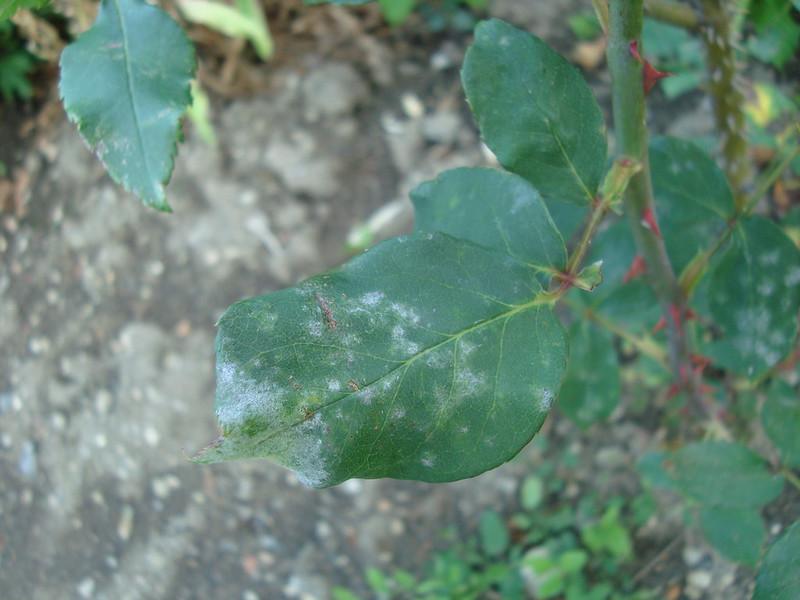
One of the most dangerous diseases affecting roses cultivated in fields and greenhouses is powdery mildew.
Downy mildew and powdery mildew are both types of the same fungus. Powdery mildew is much more frequent than downy mildew, but downy mildew is more likely to develop on roses that have been cultivated under glass.
Extreme temperature swings between the day and night might be a contributing factor to the development of powdery mildew on roses, as can a lack of ventilation in the area.
As the mildew infection starts, young leaves will start to pucker or wrinkle before mold starts to grow on them along with stems. As the infection progresses, a thin white coating spreads across the entire rose bush.
If mildew is left unchecked, it will eventually spread to older leaves, stems, flower buds, and other plant parts, preventing them from developing.
Control
Not much can be done once a rose plant is affected with powdery mildew. The only piece of advice we can give is that a well-kept rose will be less vulnerable to mildew than one that has been neglected and grown poorly.
However, to stop powdery mildew from spreading, use a specialized fungicide, and get rid of any damaged leaves as soon as possible.
Frequently Asked Questions
What can I spray on roses for bugs?
In most cases, rose slugs feed only at night. Depending upon the species, young rose slugs feast on either the top or bottom portions of leaves between veins, leaving behind a “window” of opaque tissue that eventually turns brown.
What is stripping the leaves off my roses?
A heavy infestation of rose slugs can deprive your plant of all its leaves. These are nocturnal feeders, and they are most active in the early spring to late summer. These slug-like critters, the larvae of the black fly, are responsible for consuming the flesh of a rose leaf, leaving only the veins remaining.
Can you spray roses with soapy water?
To protect roses from insect infestation, you can spray them with soapy water. However, roses should be sprayed in the morning so the soap can dry completely. There is a chance that the soap will burn the leaves if it does not dry rapidly enough.
Should I remove damaged leaves from roses?
If your roses become infected, remove the affected leaves. Any contaminated canes should also be pruned and thrown away as well. In the fall, rake up and remove the leaves from beneath the plant. Choose a fungicide that manages black spots and powdery mildew if the disease is severe enough to require chemical control.
Is vinegar good for roses?
Using too much vinegar on your roses can be dangerous to their health and cause them to wilt. Its effects can be felt not just on the roses but also on the nearby plants. However, if your rose plants are suffering from a bug infestation, you can use a mild vinegar solution to combat the problem.
What time of day is best to spray roses?
You should spray your roses as early in the morning as possible before it gets too hot. However, you should wait until the sun is up to allow the sun to help dry the spray. Also, avoid spraying your plants too late in the day to keep them damp.
What is biting off my rose buds?
Budworms, sometimes known as tobacco budworms, are nasty bugs that damage rose buds and blooms on rose bushes. In addition, squirrels can nip off the buds of a wide variety of plants as they mistake them for food, chew on them, and then spit them out since they do not enjoy the taste.
Sources For Further Readings
Rose Insects & Related Pests. (2022). Retrieved 3 August 2022, from https://hgic.clemson.edu/factsheet/rose-insects-related-pests/
Insect Pests of Roses | Mississippi State University Extension Service. (2022). Retrieved 3 August 2022, from http://extension.msstate.edu/publications/publications/insect-pests-roses
Common Insect Pests of Roses. (2022). Retrieved 3 August 2022, from http://www.uky.edu/Ag/Entomology/treepestguide/rose.html
Roses: Insects and Mites Management Guidelines–UC IPM. (2022). Retrieved 3 August 2022, from http://ipm.ucanr.edu/PMG/PESTNOTES/pn7466.html
Editor’s Recommendations
54 Gorgeous Rose Pink Flowers (With Pictures)
What Is Eating My Pea Plants? Causes, Solution & Prevention
What Is Eating My Petunias & How Can I Save Them? | All You Need To Know!







